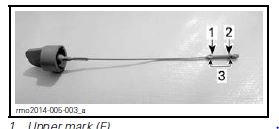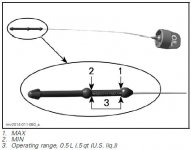..... CanAm must have made rocket science out of it.
They haven't really, it's all pretty much standard operating procedure for many High Performance
DRY SUMP engines, where the oil reservoir is
NOT underneath the block where all the oil will drain into it when you pour it in! And that's
DEFINITELY NOT like most 'most other' motorcycles &/or cars, where they have that 'lowest point in the system' collection pool/sump underneath everything for all the oil to run down into so that you can easily check it & so that it's cheap & easy to make & for things to 'splash around in a puddle of oil' and
MAYBE get lubricated properly that way!!

In Dry Sump engines, the oil reservoir is elsewhere, possibly above the lowest point in the engine, and all the oil necessary for lubricating & cooling the critical operational parts gets delivered to those critical parts by pumps & returned to the reservoir (with its level check/dipstick device) by pumps, often by 'other' pumps at that!! So if you just chuck the oil in & add until it reaches the 'Full' level in the reservoir on a Dry Sump engine, there's a good chance you'll have overfilled the block with oil, maybe even to the extent that there's no longer enough space between the bottom of the pistons & the top of the oil level for those pistons to complete a full revolution of the crank without smacking into the (non-compressible) over-full oil level! Or maybe you will have over-filled it with oil to the extent that the reservoir has leaked all the excess oil out into the over-head valve gear, filling that cavity & stopping them from working properly; or possibly to the extent that it's already filled or once started will fill the air intake tracts with over-flowing oil, ultimately draining said oil into and filling the combustion chambers with (non-compressible) oil!! Any/all of which might be on the 'worst case scenario' end of the scale, but any/all of which can produce pretty dramatic and definitely terminal results for your engine!! shocked:
Dry Sump engines are a little more complex than the engines in most cars & many motorbikes, simply because they tend to be used in different & often high performance demand situations - sometimes it's just due to the need to squeeze them into a shorter tighter space (possibly like the rather cramped space under the tupperware) or possibly it's because the engine they support is running closer to the limits of its 'power for capacity output'; or it could simply be because the designer wants a more definite & measurable way of delivering
EXACTLY the correct amount of oil to
EXACTLY the spot it's needed in order to keep those critical operational components safe, lubed up, and cooled appropriately!! :lecturef_smilie: And a wet sump can't do any of that anywhere near as well as a dry sump can!

Sure, you could probably stick a normal & agricultural 'wet sump' engine in a Spyder; one where most of the bottom end lubrication comes from important things splashing around in a puddle of oil as they spin..... heck, it might even be cheaper to make an engine like that too - but it'd almost certainly make for a taller engine that'd impact the CoG of your Spyder adversely; it'd probably mean the Nanny would hafta be more intrusive in order to minimise oil surge in that puddle & therefore any subsequent oil starvation to some of those critical components during cornering because of the greater affect of 'centrifugal forces' resulting from the higher CoG; and it'd almost certainly mean the engines we'd get would have less power & torque output as a result of the changes forced upon the engineers & designers if they stuck with the 'oil in a puddle under the engine' storage, cooling, and lubrication system instead of using a 'purpose designed, delivery of oil to exactly the right spots in a measurable way that's not varied by centrifugal forces system' like the Dry Sump system that our Spyders and many other cutting edge high performance engines get -
because they ARE BETTER at doing that job PROPERLY!!
And yes, running a dry sump engine does mean that you need to use a different 'oil level checking' method to that you'd use for a 'splash things in a puddle' engine, but at least IMHO, the advantages
FAR outweigh the disadvantages.... and by checking the oil using the correct checking method for our Spyder Dry Sump Engines, I get yet another excuse for taking a ryde!! And I
KNOW that since I checked the oil level when I stopped last, then unless there's a big puddle of oil under my Spyder, the oil level is correct and my Spyder is ready to go - now! :2thumbs:



